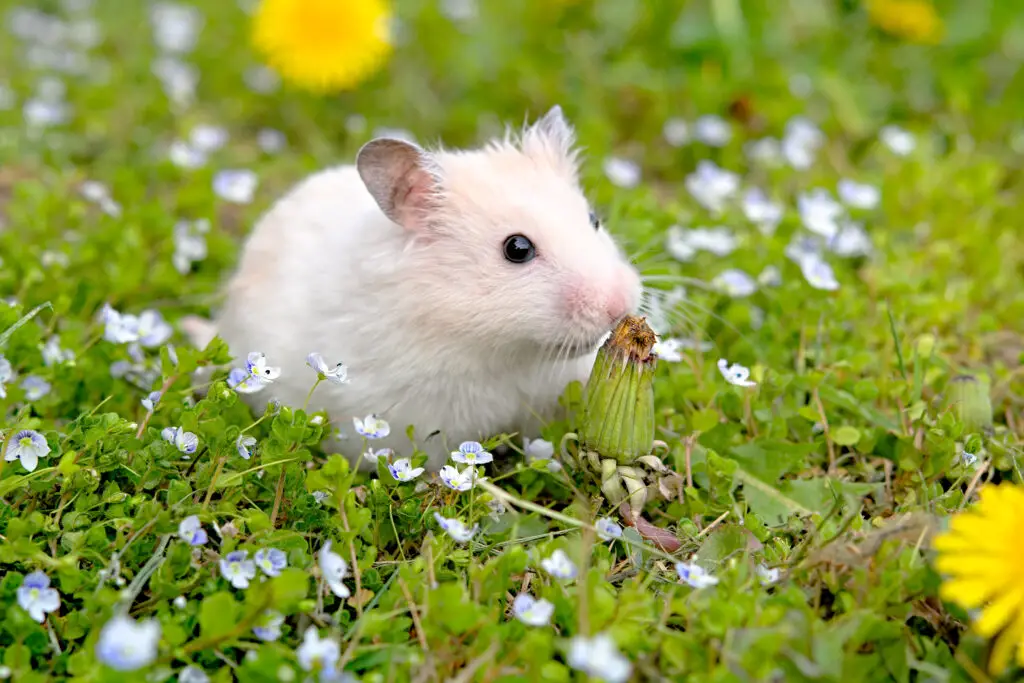Syrian hamsters are one of the most popular pet rodents in the world, and it’s easy to see why. Their adorable appearance combined with their crazy antics make them very loveable pets!
In this article, we’ll go over 10 facts about the Syrian Hamster that you might not know. Let’s dig in!
Prefer video? We’ve got you covered!
10 Syrian Hamster Facts
1. Female Syrian Hamsters are known as attentive and careful mothers.
While Syrian hamsters are generally solitary, mothers are very protective of their babies. When the offspring are threatened, the female takes the babies in her cheek pouches, carrying them to a safe place to protect them from harm!
2. Syrian Hamsters have poor vision and rely on their keen sense of smell to get around

Due to the poorly-developed vision, Syrian Hamsters rely on their scent glands, which are located on their backs. These glands produce a characteristic odor. Syrian hamsters navigate their environment through leaving a trail of scent, which they do by rubbing their backs against various objects. This scent trail often helps them find their way when lost.
In addition to navigation, the chemical they emit also help them communicate. For instance, since Syrian Hamsters are solitary, they can detect the chemicals of other hamsters to know where their territory is so that they can avoid it. This is very useful, because hamsters do not take kindly to intruders and will fight off any hamster that invades their territory.
3. Syrian hamsters are notorious for hoarding
In order to survive throughout winter months, where food is scarce and less readily available, Syrian hamsters stockpile sufficient amount of food in advance.
However, in time, a part of their stockpiled food undergoes fermentation and produces alcohol. As a result of this, the food is not edible anymore, at least, so you’d think. Syrian hamsters are able to consume and metabolize it, despite the fact that it is fermented, due to their considerably large livers. In fact, this unique ability of Syrian hamsters makes them suitable species for alcohol studies.
4. Syrian Hamsters can learn to recognize and respond to human voices.
If you have a Syrian hamster as a pet that you spend a lot of time with you’ll notice that over time they’ll learn to recognize your voice. They might come out of their hiding place when they hear you talk because they want to interact with you.
If your hamster does not seem to respond to your voice, don’t worry. It often takes a bit of time before they’re able to recognize voices. Make sure to talk to your hamster frequently so that it can get used to your unique voice.
5. In the wild, Syrian hamsters are capable of creating immense burrows.

These rodents might be small, but they’re definitely capable of building great things. In the wild, burrows belong to Syrian Hamsters have been found that are over 9 meters in length! Because Syrian hamsters like to burrow, it’s important that in captivity they’re provided with appropriate bedding that allows them to do so.
6. Syrian Hamsters have intricate body language.
Their body language allows them to display a range of emotions that include being: happy, afraid, threatened, startled, angry, or stressed.
For example, Syrian hamsters are known to communicate anger through teeth chattering and freezing in place means that they’re afraid. Learning to read your hamster’s body language is a great way to understand them and their feelings better.
7. Syrian hamsters are native to Syria and Turkey.
While most people see these little rodents in pet shops, they’re originally from the north of Syria and the South of Turkey where they live in dry arid places like deserts and dunes. There, they feed on a variety of different seeds, insects, and plants.
8. They are omnivorous.
Most people feed their hamster a commercial feed mix, but did you know that hamsters can also eat insects and small amounts of meat? Try giving your hamster a small piece of cooked plain chicken and you’ll see that they’ll most likely love this source of protein. In addition to meat and plants, these little rodents can also eat eggs, and it’s a treat that they enjoy a lot!
9. Syrian Hamsters come in a variety of colors.
While these cute rodents also go by the name of Teddy Bear hamster or Golden hamster, they can actually have a variety of different colors. For instance, they can be beige, black, blonde, brown, chocolate, cream, and many other colors.
In the wild, they do not come in all these colors and are often a golden color with a white underbelly. However, selective breeding in captivity has resulted in them having such a diverse range of colors. Because of this, if you want to buy a hamster as a pet, you have a wide range of colors to choose from.
10. Syrian Hamsters can go into false hibernation if they’re cold.
If temperatures in their enclosure drop below 40 degrees Fahrenheit, your Syrian hamster might go into false hibernation and enter a state called “Torpor”. During this state, it may seem like your hamster is asleep or even dead. Hamsters enter this state of Torpor in cold temperatures because it’s triggered by a mechanism to conserve energy. If you think your pet hamster has entered false hibernation, you should gradually raise the temperature in the space. You can put a heated pad over the Syrian hamster or a hot water bottle in the cage to raise their temperature gradually.
Wrapping up
So, there you have it, the top 10 most interesting facts about Syrian Hamsters! I hope that this article was fun to read and taught you something new about these fascinating little rodents.
- How Long Do American Eskimo Dogs Live? Important Factors and Care Tips - September 29, 2023
- Do American Bulldogs Need Grooming? Essential Tips and Care Guidelines - September 29, 2023
- Do Bengal Cats Enjoy Playing? Essential Tips for Keeping Them Active - September 29, 2023